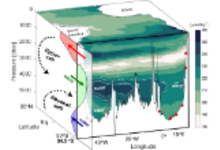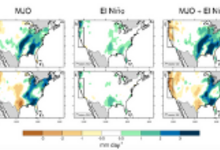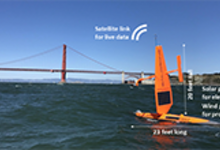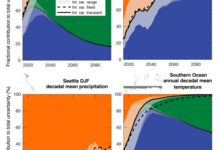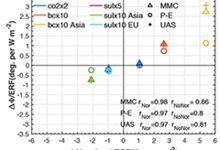Research Highlights
We aim to feature the latest research results from US scientists whose published paper features work that is sponsored by one or more sponsoring agency programs of US CLIVAR (NASA, NOAA, NSF, DOE, ONR). Check out the collection of research highlights below and sort by topic on the right. Interested in submitting an article for consideration? See our Research Highlight Submission Guidelines page for more information.
Kersalé, Meinen, and coauthors investigate the MOC flows at the southern end of the South Atlantic Ocean to evaluate the variability of the oceanic circulation across 34.5°S in the South Atlantic at all depths and at a daily frequency. This research highlights the first-ever daily quantification of the time-varying strength of the abyssal cell at 34.5°S, for which prior studies had only produced once-a-decade "snapshot" ship section estimates.
Subseasonal to seasonal climate forecasts in the US depends heavily on atmospheric and oceanic conditions in the tropical Indian and Pacific Ocean regions. While ENSO dominates seasonal predictability, the primary source of global predictability on subseasonal timescales is the MJO. To understand how ENSO and MJO interact, the authors isolated both MJO and ENSO signals and found that depending on the simultaneous location of the MJO convection and the background state of ENSO, the two signals can either enhance or mask each other.
To improve atmospheric and oceanographic monitoring, a new type of autonomous marine vehicle, the Saildrone, has been developed and deployed in over 40 cruises from which data are publicly available. Coupled with data from other sources such as satellites, Saildrone measurements could be useful for future algorithm and numerical model improvements, particularly at the fine spatial scale and in complex and previously data-sparse ocean regions.
A new collection of single model initial-condition large ensembles (SMILEs) can test statistical assumptions with a cleaner separation between sources of uncertainty in climate projections. In particular, the potential bias at regional scales or for variables with a lot of internal variability can be greatly reduced.
Internal variability and anthropogenic forcing have contributed to the widening of the tropical belt during the last several decades. To better understand the effect of individual anthropogenic drivers (including aerosols) on the tropical belt, Zhao, Allen, and coauthors utilize idealized simulations with very large single forcing perturbations in comprehensive coupled ocean-atmosphere models from the PDRMIP.

